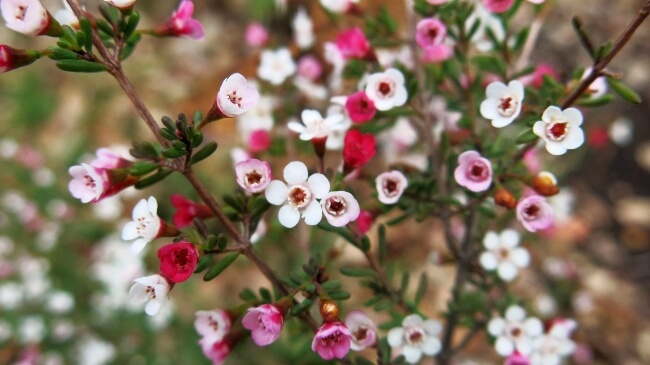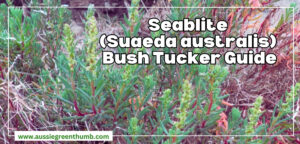Chamelaucium, the waxflower, isn’t just a good looking shrub, but a practical low-maintenance one too. Its foliage is packed with citrusy scent, which wards off pests, and its beautiful blooms last for weeks in a vase.
If you’ve ever wanted to grow this stunning native, but not known where to start, we’ve got you covered. Plus, everything you need to know about this native plant, and the thirteen species that all grow in the most southerly parts of WA.
More...
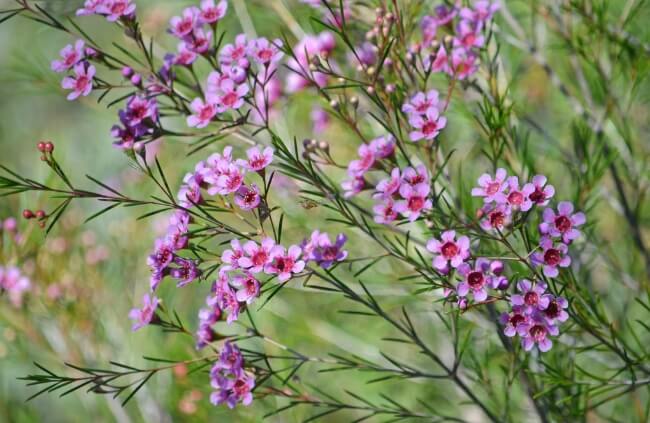
Family: | Myrtaceae |
|---|---|
Genus: | Chamelaucium |
Species: | Various |
Origin: | Southwestern Australia |
Common Names: | Waxflower |
Location: | Outdoor |
Type: | Flowering shrub |
Growth: | up to 3 metres tall |
Sun requirements: | Full sun |
Foliage Colour: | Green |
Flower Colour: | White and pink |
Flowering: | Winter to Spring |
Edible Parts: | Edible flowers and leaves |
Maintenance level: | Low |
Poisonous for pets: | Non-toxic to cats and dogs |
What are Waxflowers?
Waxflower is the common name for a small group of shrubs in the genus, Chamelaucium. The genus is entirely native to Western Australia, and endemic to the south west, where it grows largely in open land in isolation.
Chamelaucium is a member of the Myrtle family, which includes many strongly scented plants, predominantly fragranced through intensely packed oils in their foliage.
Waxflowers get their name (wax flower, waxflower, or waxplants) from their distinctly waxy petals. Those petals aren’t just attractive though, they’re useful too. Adding cut flowers with short sections of young stems to flower arrangements adds longevity to your vases, with flowers that typically last for around 14 days in water.
Natural Habitat of Chamelaucium
Waxflower shrubs are native to south Western Australia. They grow in open land in full sun, and high exposure to winds. Their fine foliage lends itself well to these conditions and makes it incredibly resilient in exposed gardens.
List of Chamelaucium Species
There are thirteen definitively recognised species of Chamelaucium (waxplants), all native to WA, and all fit for garden use, though only three are commonly cultivated and sold through garden centres, or available in collations outside of their natural habitat.
1. Chamelaucium uncinatum (Geraldton waxflower, Geraldton wax)
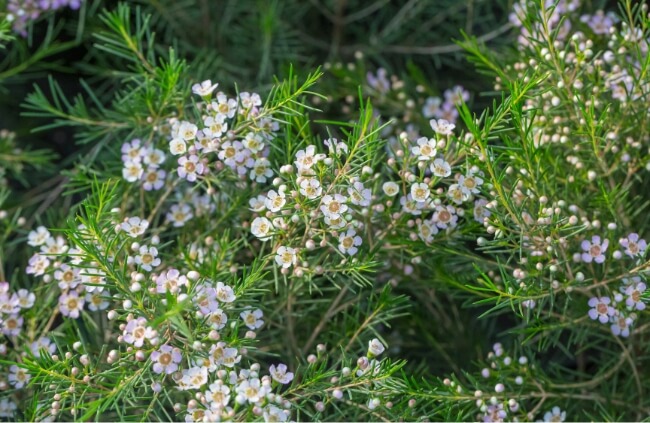
The most commonly cultivated waxflower in Australia, but also the rest of the world is the ever-popular Geraldton wax (C. uncinatum), with bright, verdant foliage, in densely packed needles all along the stem, that holds as a formal evergreen shrub, and responds beautifully to pruning.
For a month in late summer, this member of the myrtle family is at its most fragrant, with generous coatings of pink and white flowers opening for deep, pink coloured buds.
Learn more about this famous species with the help of our in-depth Geraldton wax growing guide.
2. Chamelaucium brevifolium
This diminutive waxflower reaches about 1 m tall, but in nature is rarely found growing above 30 cm. It grows on sandy ground and tolerates drought exceptionally well, but is widely ignored by gardeners thanks to its wiry appearance, and untidy winter wrangle of branches.
3. Chamelaucium ciliatum
C. ciliatum is a brilliant choice for gardens with less than ideal soil. It will grow in pretty much any conditions provided it is given full sun, and with no pruning, and balanced moisture levels it can reach around 1.5 m tall.
While it’s not a common waxflower for gardens, it’s not unknown, and offers stunningly delicate pink flowers, which open as red, and fade to pink over a long flowering period that can sometimes last right through from late winter to autumn.


Get Your Free Guide:
Master Growing Australian Natives eBook
A Must Have Complete Guide for Every Australian Garden
Get Your Free Guide:
Master Growing Australian Natives eBook
A Must Have Complete Guide for Every Australian Garden
4. Chamelaucium confertiflorum
C. confertiflorum is unlikely to be found in gardens. It grows almost entirely on sand in dryer parts of WA, and other than highly scented summer foliage, is a fairly unremarkable species of waxflower, with sparse white flowers on wiry stems, reaching a maximum of about 60 cm tall.
5. Chamelaucium drummondii

Source: Wikipedia
This summer flowering waxflower can reach 2 m tall with tightly packed flowering tips on its long arching stems. The buds open from a pale pinky-white to reveal pink centres to crisp, white petalled flowers, and grow beautifully on most soil types.
The flowers of Chamelaucium are individually bolder too, with double layers of petals, and red sepals, making for a gorgeous dense display on this captivating native.
6. Chamelaucium gracile
C. gracile is an unassuming species of the waxflower, found growing native in southern western Australia on sandy soils.
7. Chamelaucium heterandrum
The stems of C. heterandrum are more densely foliate, with each stem typically splitting into a denser mass before flowering from the tip. As with most non-cultivated waxflowers, it grows in a range of soils in exposed spots in WA, and reaches around 1m high.
8. Chamelaucium marchantii

C. marchantii is a more distinct species of waxflower, with an overall domed shape, yellow-green flowers and a tendency to flower for a brief period in spring.
Its incredibly fine blue-green leaves are perfectly suited to wind locations, and it specifically thrives in the wind tunnels of sandy creeks.
9. Chamelaucium megalopetalum (Large waxflower)
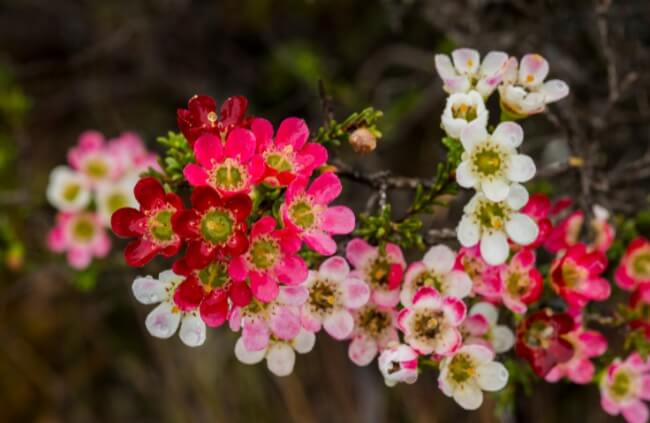
Preferring loose, gravel-rich soils, the large waxflower (C. megalopetalum) is named for its sparse but individually large flowers, which grow from multiple new shoots along each stem. The foliage tends to be tight, rounded and short, rather than the feathery needles we’re more used to with this genus.
The large waxflower’s overall appearance as a shrub is fine, and open, allowing light to pass through and offering little shade.
10. Chamelaucium micranthum
C. micranthum is fairly uncommon in gardens, but quite a normal sight in commercial cultivation thanks to two specific cultivars, C. micranthum ‘Tal’, and C. micranthum ‘Moon Star’. Both are regular features in floral bouquets, thanks to their softer, pastel whites, which fade to a creamy grey, making for a beautifully soft base to any foliage-heavy flower arrangement.
C. micranthum is a highly productive species, and grows to around 4 m tall.
11. Chamelaucium pauciflorum
One of our more delicate native shrubs is C. pauciflorum. While you might not see it in a garden near you any time soon, it’s worth looking out for on heaths and open lands, particularly on exposed ridges, where its bright red buds open alongside cream coloured flowers for several months at a time.
It rarely grows taller than 1 m, but is easy to spot thanks to its slender exposed stems, covered in short stations of stubby needles.
12. Chamelaucium axillare (Esperance waxflower)
The Esperance waxflower, C. axillar, is a tall, upright shrub, with fine, needle-like foliage. It is one of the best waxflowers for garden use, but is generally less popular than the Geraldton waxflower, for reasons I don’t fully understand.
Its unique beauty lies in its seasonal shifts, with stunningly fine evergreen foliage, allowing dappled light into the garden all year round, but offering privacy too. Its buds open up as tight red pin heads, before opening into delicate white blooms that cover the entire plant.
If you’re looking to break the mould with something slightly out of the ordinary, the Esperance waxflower is a really wonderful shrub.
13. Chamelaucium virgatum
Again, you’re unlikely to find C. virgatum waxflowers on sale in a garden centre, or stumble over one in a local garden, but they are prolific in Western Australia, and boast one of the longest flowering periods in this genus, between August and January.
Their needles are plump, and incredibly fragrant, with ornate flowers in dense groupings, over a sparse but domed shrub.
How to Grow Waxflowers
Waxflowers aren’t remotely difficult to grow in Australia, but you do need to get their condition right before planting them as it’s hard to alter them later.
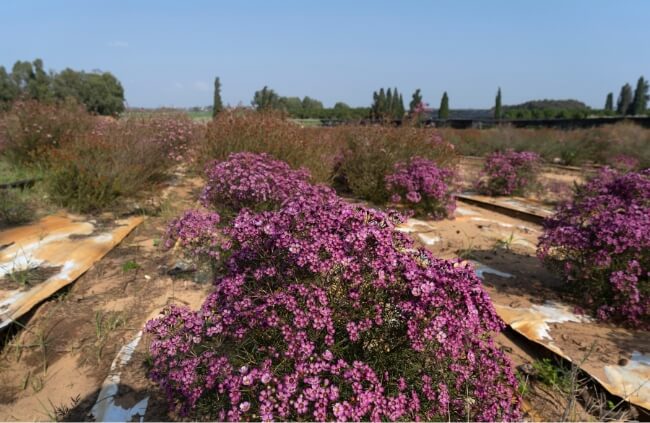
Ideal Conditions for Growing Waxflowers
Soil for Waxflowers
All species of waxflowers need well-drained soil, and do best on soil that has been improved with sand, grit, or gravel to ensure that it doesn’t get even slightly waterlogged.
If you have clay soil, whether it’s damp clay, dry clay, heavy clay, or improved clay, you will need to dig out several feet of soil to provide suitable drainage, so it’s generally easier to grow your waxflower shrubs in large containers instead.
Positioning Your Waxflowers
Waxflowers need full sun. They can cope with some very light shade, but I’d be misleading you if I said it was the right choice. Full sun supports their ideal soil conditions, it enriches their leaf fragrance and oil production, and prologues flowering by several weeks compared to growing waxflowers in partial shade.
If you don’t have full sun, it will still grow, and flower, but if you can offer an exposed spot, all the better. It’s also worth noting that Chamelaucium are well adapted to very windy, exposed conditions, so don’t be afraid to plant the shrubs out on their own, or in exposed swathes for a fuller effect.
Growing Waxflowers Outdoors
Waxflowers are shrubs, but that doesn’t mean they can’t be grown either indoors or out. However, for best results, a good, open, exposed spot, with protection from frost outdoors will be ideal and allow most species to reach 1-2m tall with time.
Make sure your planting spot has good sun, and good drainage, and then loosen up the soil at the base of the planting hole with a fork, ensuring the roots have some space to spread out after planting.
Despite requiring good drainage, really drench it as soon as you’ve backfilled the soil to make good contact with the roots, and then don’t water again unless there is a hot dry spell within the first few months of planting.
How to Grow Waxflowers Indoors
Waxflowers, particularly in colder climates, can be grown indoors. This will limit their growth, but with regular pruning, they can be kept to about 30 cm tall, and will continue to flower beautifully for harvesting cut flowers, or simply enjoy their fragrance.
Plant waxflowers into pots filled with gritty compost, and water them only when the top couple of inches of soil are dry to touch. Give them full sun in a bright window or greenhouse, and if possible, move them outdoors for the summer months.
How to Propagate Waxflowers
Waxflowers have flowers, and by their very nature, produce seed. That can be harvested and propagated either fresh or from stored seeds, but, and it’s a big but, there’s such a low success rate that it’s barely worth trying.
Instead, take cuttings from your waxflower shrubs in late summer or early autumn, once the flowers have finished, and the stems are mature but still flexible.
Cut about 15 cm of a shoot that has grown this year, but begun to mature. Remove all of the foliage from the bottom half of the cutting, and make a clean cut below the lowest node (the closer to the node the better).
Dip the cut end in rooting powder, and then poke it into a loose, gritty soil mix. Keep the cutting somewhere bright, but protected from direct sunlight, and water lightly but regularly through autumn and winter. By spring you should see signs of new growth, and well established roots.
Waxflower Care Guide
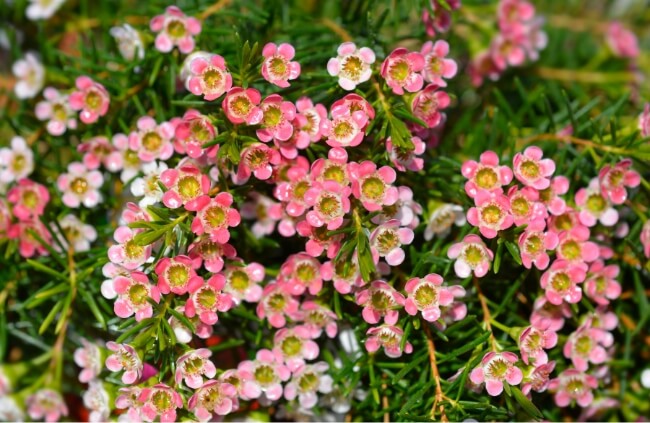
Feeding and Mulching
Waxflowers don’t need feeding. In the rare case that they show signs of yellow leaves, leaf drop, or noticeably slower growth in spring, run a quick soil test, and adjust as necessary with either liquid feeds (low phosphorus as they are very sensitive to available phosphorus in the soil or water) or soil improvers.
Avoid mulching waxflowers at any time of year as this will only serve to hold moisture in around the base which can harm the plant.
Waxflower Water Requirements
Waxflowers don’t need watering once established. Chamelaucium are completely able to cope with prolonged droughts and hot summers, so once they have established well in your garden… don’t water them.
In containers, they do need some watering through summer to maintain the soil health, and stop it from cracking, as with any container plant, so water deeply once a fortnight to make sure the soil doesn’t begin to crack away from the side of the pot, and then not at all through winter.
Pruning Waxflowers
Waxflowers, like most members of the myrtle family, respond really well to pruning evenly all over after flowering, promoting new growing tips that will flower the following year.
For a looser effect, you can leave waxflowers uncut to develop into a beautifully informal shape, but you’ll nearly always get a better display by pruning all over with clean, sharp hedge shears as soon as flowers fade.
Repotting Waxflowers
If your waxflower is showing signs of nutrient deficiencies in a container, it’s usually a sign of restricted roots. They are used to free-draining, loose soils, and their roots will grow out of the base of containers if they are restricted. If that’s the case, simply tip the plant out as gently as possible, and tease the roots, shaking soil away as you go.
Plant your waxflower shrub back into a slightly larger container with some organic compost, and grit mixed in around the edges. Water it in and bash the sides of the pot with your hand to remove air pockets.
Common Waxflowers Pests and Diseases
As a member of the myrtle family, waxflower is pretty well protected against bugs and insects, simply because of its pungent essential oils that pack out every leaf and make it distasteful to pests.
However, that doesn’t make it immune to damage, as overwatering is a sure-fire way to promote fungal problems around the base of the plant and underground.
The most common disease when growing waxflowers is Phytophthora rot, a fungal pathogen that takes over roots, preventing them from taking up nutrients, and in severe cases, water, causing yellow or dropping foliage.
As it develops, the rot will travel up to the base of the stem, and young stems, mature growth and any other part of the plant can become mushy. There is no cure once it sets in, so avoid overwatering, and fix damp soil as soon as possible by letting it dry out, or by repotting your waxflower.
Harvesting Waxflowers for Cut Flowers

Wax flowers should be harvested on their stems, similarly to gypsophila. Their flowers are used in a similar way in bouquets, but with sturdier, longer lasting uses, and brilliantly fine foliage that adds depth, but without distracting from arrangements.
Using a decent pair of scissors, cut just above a node, removing about 30 cm of stem. This will encourage well-shaped regrowth, and provide a good length for your vase (also helping to support other flower stems inserted later).
Strip off the lowest leaves so they won’t rot off in the water, and then trim each stem just below a node to promote more efficient water uptake in the vase. The cut stems, packed with beautiful waxy flowers, should last for around 14 days
Bush Tucker Tips: How to Use Waxflowers
Waxflower flowers and leaves aren’t toxic, and are generally seen as edible, but if you’re planning on growing one specifically for eating, try Chamelaucium ‘Jambinu Zest’, which has been specifically bred from Geraldton Wax for a better flavour.
Their pungent essential oils are intensely and deliciously lemony, with a vibrant fragrance that’s almost mentholated. The leaves are firm and hold their shape and texture so work best when cooked, or dried and ground as a seasoning (gorgeous sprinkled on savoury rice).
Waxflowers Frequently Asked Questions
Is waxflower evergreen?
Waxflowers are evergreen shrubs that can be grown indoors, outdoors, and in greenhouses, but always look at their best when grown to full height shrubs, leaving filtered light to flower into the garden through tall slender stems.
How long does waxflower last in a vase?
Waxflowers tend to last for 10-14 days in a vase, but with clean cutting tools, mild indoor temperatures, and a light splash of white vinegar in the water, they can last for 3-4 weeks before they start to fade.
How often do waxflowers bloom?
Waxflowers bloom once a year, usually in late spring or early summer, though some are known to flower continuously until the end of autumn. If you cut back spring flowers straight after flowering, they will very occasionally re-flower in autumn.
Do waxflowers smell?
Waxflowers have a subtle sweet fragrance, generally overpowered by the lemony scent of their foliage if any is left on the stem in a vase.
Are waxflowers pet safe?
Wax flowers are completely safe for dogs, cats, and horses, and are rarely eaten by them anyway thanks to their foliage scent. If they do eat them they would need to eat a vast amount to cause a small amount of digestive upset.
Wrapping Up Our Guide to Waxflowers
It’s not all too often that we think of shrubs as cut flowers. Some low-growing perennials like gypsophila or frothy shrubs like spirea and shrub roses are obvious candidates, but none have anywhere as much value to floral arrangements as waxflowers.
Their simple, delicately coloured foliage is long-lasting, tough, and boosted by the gentle lemony fragrance of the foliage and stems, making a wonderful soft alternative to common vase fillers. If you needed a reason to grow waxflowers at home, surely that’s it.
Published on September 3, 2023 by Gary Clarke
Last Updated on October 18, 2024

